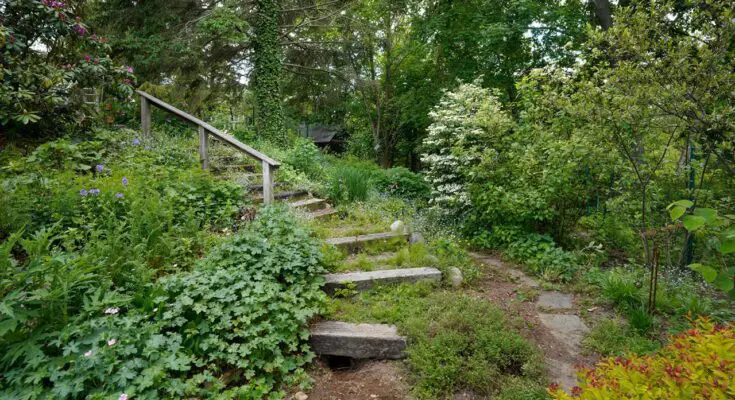Introduction
The conventional grass lawn has long been the hallmark of the idyllic American backyard, but this manicured aesthetic comes at a significant environmental cost. From the excessive water consumption and chemical inputs required to maintain a lush, green carpet to the polluting emissions of gas-powered mowers, the traditional lawn has become an unsustainable relic of the past. Fortunately, a growing movement towards eco-friendly landscaping has given rise to a wealth of alternative options that not only reduce our carbon footprint but also enrich local ecosystems and add captivating visual interest to our outdoor spaces.
In this comprehensive guide, we’ll explore a diverse array of sustainable lawn alternatives, each offering unique benefits to homeowners seeking a more environmentally conscious approach to their landscape. Whether you’re drawn to the low-maintenance allure of groundcovers, the vibrant tapestry of native wildflowers, or the serene beauty of a moss-covered oasis, you’ll discover a wealth of possibilities to transform your yard into a verdant, wildlife-friendly haven.
The Drawbacks of the Traditional Grass Lawn
The traditional grass lawn, while visually appealing, is fraught with many environmental and practical drawbacks. From the excessive water consumption required to maintain a lush, green carpet to the reliance on chemical fertilizers and pesticides, the conventional lawn has become a significant contributor to environmental degradation.
Water Consumption
Grass lawns are thirsty beasts, requiring an average of 4-5 liters of water per 10 square feet to stay verdant and healthy. This constant need for irrigation places a heavy strain on urban water infrastructure, especially in regions affected by drought and climate change.
Chemical Inputs
The quest for the perfect lawn often leads homeowners to rely on a cocktail of synthetic fertilizers, herbicides, and pesticides. These chemical treatments not only pollute the soil and waterways but also pose a threat to the delicate balance of local ecosystems, harming beneficial insects and wildlife.
Emissions and Maintenance
The regular mowing required to keep grass short and tidy comes with its own environmental cost. Gasoline-powered lawn equipment releases a significant amount of harmful pollutants, including volatile organic compounds (VOCs) and criteria air pollutants, contributing to poor air quality.
Lack of Biodiversity
Monoculture grass lawns offer little to no value for local wildlife, depriving pollinators, birds, and other beneficial organisms of the food and habitat they need to thrive. This lack of biodiversity can have far-reaching consequences for the health of the entire ecosystem.
Embracing Eco-Friendly Lawn Alternatives
In response to the growing awareness of the environmental impact of traditional grass lawns, a diverse array of sustainable alternatives has emerged, each offering a unique set of benefits and visual appeal. By exploring these options, homeowners can transform their outdoor spaces into vibrant, low-maintenance havens that support local ecosystems and reduce their carbon footprint.
Native Grasses and Wildflowers
Reclaiming the natural beauty of regional grasslands, native grasses and wildflowers offer a stunning and ecologically beneficial alternative to the monoculture of turf grass. Species like Big Bluestem, Little Bluestem, and Switchgrass thrive with minimal water and maintenance, while providing vital food and shelter for a wide range of native pollinators and wildlife.
The Beauty of Native Grasses
Native grasses offer a captivating visual display throughout the seasons, transitioning from vibrant green in the spring to golden hues in the fall. Their tall, swaying stems and delicate seed heads create a mesmerizing, naturalistic landscape that evokes the spirit of the wild prairie.
Wildflower Meadows
Integrating native wildflowers into your lawn alternative can further enhance the biodiversity and visual interest of your outdoor space. Species such as Coneflowers, Black-Eyed Susans, and Milkweed not only add a burst of color but also provide essential nectar and pollen sources for pollinators.
Low-Maintenance Benefits
Native grasses and wildflowers are inherently adapted to the local climate and soil conditions, requiring far less water, fertilizer, and mowing than traditional turf grass. This significantly reduces the time, effort, and resources needed to maintain a lush, healthy landscape.
Groundcovers
Groundcovers offer a versatile and low-maintenance alternative to traditional grass, creating a dense, carpet-like coverage that can thrive in a variety of conditions. From the fragrant, creeping thyme to the resilient Corsican mint, these hardy plants require minimal watering and mowing, while providing a welcoming surface for foot traffic.
Diversity in Groundcovers
Groundcovers come in a wide range of textures, colors, and growth habits, allowing homeowners to tailor their landscape to specific needs and aesthetic preferences. Whether you prefer the velvety softness of Irish moss or the vibrant hues of sedum, there’s a groundcover to suit every taste and growing condition.
Ecological Benefits
Many groundcover species are also beneficial to local ecosystems, attracting pollinators and providing shelter for small wildlife. By incorporating these plants into your landscape, you can create a thriving, biodiverse oasis that supports the delicate balance of nature.
Low-Maintenance Advantages
Groundcovers require far less maintenance than traditional grass lawns, with minimal or no mowing, watering, or chemical treatments needed to keep them healthy and lush. This not only reduces your environmental impact but also frees up time and resources for other gardening projects.
Moss Lawns
For shaded, moist areas where grass struggles to thrive, moss lawns offer a captivating and low-maintenance alternative. Moss species like Fern Moss, Pincushion Moss, and Scotch Moss form a soft, verdant carpet that requires no mowing, fertilizing, or watering, making them an ideal choice for eco-conscious homeowners.
The Beauty of Moss
Moss lawns provide a tranquil, natural aesthetic, with a range of hues from vibrant emerald to golden-green. Their velvety texture and gentle undulations create a serene, almost meditative atmosphere, perfectly suited for shaded nooks and pathways.
Ecological Benefits
Moss is a crucial component of many natural ecosystems, providing food and shelter for a diverse array of organisms, from tiny invertebrates to small amphibians. By incorporating moss into your landscape, you can help support the local biodiversity and create a thriving, self-sustaining ecosystem.
Low-Maintenance Simplicity
Moss lawns require virtually no maintenance, as they are self-sustaining and adapt to their environment. Once established, they require no mowing, watering, or chemical treatments, making them an exceptionally low-effort and eco-friendly choice for homeowners.
Clover Lawns
Clover has long been a beloved companion to traditional grass lawns, but it is now gaining recognition as a viable and environmentally-friendly alternative in its own right. Clover’s deep root system, nitrogen-fixing properties, and resilience to drought and foot traffic make it an attractive choice for homeowners seeking a lush, low-maintenance ground cover.
The Benefits of Clover
Clover’s ability to fix nitrogen in the soil helps to enrich the earth, reducing the need for synthetic fertilizers. Additionally, its deep, fibrous roots help to aerate the soil and prevent erosion, while its resistance to drought and wear makes it a hardy and reliable choice for high-traffic areas.
Pollinator-Friendly
Clover’s abundant blooms provide a rich source of nectar and pollen for bees, butterflies, and other pollinators, making it an essential component of a thriving, biodiverse landscape.
Aesthetic Appeal
Clover lawns offer a soft, lush texture and a delicate, flower-studded appearance that can rival the manicured look of traditional grass. Homeowners can choose from a variety of clover species, including the classic Dutch White Clover or the shorter, less-flowering Pipolina variety, to suit their desired aesthetic.
Ornamental Grasses
Ornamental grasses offer a striking and versatile alternative to traditional turf, providing a range of textures, colors, and growth habits to enhance the visual interest of any landscape. From the graceful, arching stems of Fountain Grass to the bold, upright plumes of Switchgrass, these low-maintenance plants can transform a yard into a captivating, nature-inspired oasis.
Diverse Aesthetic Appeal
Ornamental grasses come in a wide array of sizes, shapes, and hues, allowing homeowners to create a cohesive and visually striking landscape. Their seasonal changes, from vibrant greens in the spring to warm, golden tones in the fall, add an ever-evolving dimension to the outdoor space.
Ecological Benefits
Many ornamental grass species are native to local regions, providing valuable food and shelter for a wide range of wildlife, including birds, butterflies, and small mammals. By incorporating these plants into your landscape, you can support the local ecosystem and promote biodiversity.
Low-Maintenance Advantages
Ornamental grasses are generally drought-tolerant and require minimal mowing, watering, or fertilization to thrive. This makes them an excellent choice for homeowners seeking a low-effort, eco-friendly alternative to traditional grass lawns.
Xeriscape Landscapes
In regions prone to drought or water scarcity, xeriscape landscapes offer a sustainable and visually appealing solution. By embracing drought-tolerant, native plants and incorporating water-conserving design elements, xeriscape gardens can transform a water-intensive lawn into a lush, low-maintenance oasis.
Water-Wise Design
The key principles of xeriscape landscaping include grouping plants with similar water needs, using mulch to retain soil moisture, and incorporating permeable hardscaping materials that allow rainwater to percolate back into the ground. These strategies significantly reduce the need for supplemental irrigation, making xeriscape gardens an eco-friendly choice for arid climates.
Native Plant Selection
Xeriscape gardens typically feature a diverse array of drought-tolerant, native plant species that are adapted to the local climate and soil conditions. This not only reduces water consumption but also promotes the growth of native wildlife and pollinators, supporting the overall health of the local ecosystem.
Aesthetic Versatility
Contrary to the common misconception of xeriscape as a barren, desert-like landscape, these gardens can be designed to offer a rich, visually striking tapestry of colors, textures, and forms. From the vibrant blooms of Agave and Yucca to the sculptural silhouettes of Prickly Pear Cactus, xeriscape gardens can be both water-wise and aesthetically captivating.
Gravel Gardens
Gravel gardens offer a unique and low-maintenance alternative to traditional grass lawns, combining the beauty of drought-tolerant plants with the practicality of a permeable, weed-resistant surface. By replacing turf grass with a foundation of gravel, homeowners can create a stunning, eco-friendly landscape that requires minimal upkeep.
Permeable Hardscaping
Gravel gardens utilize a base of washed, small-sized gravel that allows rainwater to percolate back into the soil, reducing runoff and replenishing groundwater supplies. This permeable hardscaping approach helps to mitigate the environmental impact of traditional lawns, which can contribute to water pollution and erosion.
Drought-Tolerant Plants
The gravel garden design is well-suited for showcasing a diverse array of drought-tolerant, often native plant species that thrive in the well-drained, low-nutrient conditions. From the vibrant, succulent rosettes of Sedum to the delicate, wispy foliage of Lavender, these resilient plants require little to no supplemental watering once established.
Low-Maintenance Simplicity
Gravel gardens require minimal maintenance compared to traditional grass lawns. The gravel surface helps to suppress weed growth, while the drought-tolerant plants need little to no mowing, fertilizing, or pest control. This frees up time and resources for homeowners to focus on other aspects of their landscape design.
Herb Gardens
Transforming a portion of your lawn into an edible herb garden not only provides a bounty of fresh, flavorful ingredients for your kitchen but also offers a low-maintenance, eco-friendly alternative to traditional turf grass. Herbs like Thyme, Rosemary, and Lavender thrive in well-drained soil and require little water, making them an ideal choice for sustainable landscaping.
Culinary and Aromatic Benefits
Herb gardens not only contribute to a more self-sufficient lifestyle but also infuse the outdoor space with a captivating, fragrant ambiance. The sights, scents, and flavors of an herb-filled landscape can enhance the overall sensory experience of your backyard oasis.
Pollinator-Friendly
Many herb species, such as Lavender and Bee Balm, are beloved by pollinators like bees and butterflies. By incorporating these plants into your landscape, you can create a thriving, biodiverse ecosystem that supports the local wildlife.
Low-Maintenance Simplicity
Herbs are generally low-maintenance, requiring minimal watering, mowing, or chemical treatments to thrive. This makes them an excellent choice for homeowners seeking a sustainable, low-effort alternative to a traditional grass lawn.
Food Forests
Taking the concept of an edible landscape one step further, food forests merge the principles of permaculture with the beauty of a naturalistic, layered ecosystem. By combining fruit and nut trees, shrubs, vines, and ground-level plants, food forests create a self-sustaining, low-maintenance oasis that provides a bountiful harvest of fresh, nutrient-rich produce.
Ecological Benefits
Food forests mimic the structure and function of natural forest ecosystems, promoting biodiversity and supporting a wide range of wildlife. The diverse array of plants, each occupying a different vertical niche, creates a thriving, self-regulating system that requires minimal human intervention.
Water-Wise Design
By utilizing water-efficient, drought-tolerant plant species and incorporating water-harvesting techniques like swales and mulch, food forests can thrive with significantly less irrigation than a traditional lawn or vegetable garden.
Edible Abundance
The multilayered design of a food forest allows homeowners to cultivate a wide variety of edible plants, from towering fruit trees to ground-hugging berry bushes and leafy greens. This abundance of fresh, homegrown produce can help reduce reliance on industrialized agriculture and promote a more sustainable, self-sufficient lifestyle.
Artificial Turf
While not a purely “natural” alternative, artificial turf has evolved to become a more eco-friendly option in recent years. Modern synthetic grass products are designed to mimic the appearance and feel of natural turf, while offering a range of benefits that can make them a viable choice for some homeowners.
Water Conservation
Artificial turf eliminates the need for constant watering, significantly reducing water consumption and the strain on local water resources. This makes it an attractive option for regions facing drought or water scarcity.
Reduced Maintenance
Once installed, artificial turf requires minimal maintenance, with no mowing, fertilizing, or pesticide application necessary. This can free up time and resources for homeowners, while also reducing their carbon footprint.
Improved Drainage
Many artificial turf products are designed with permeable backing or infill materials, allowing rainwater to percolate back into the soil and reducing the risk of runoff and erosion.
It’s important to note that while artificial turf can offer some environmental benefits, it is not a completely sustainable solution. The production and disposal of synthetic materials can still negatively impact the environment. Homeowners should carefully weigh the pros and cons and consider other eco-friendly alternatives before deciding on artificial turf.
Designing an Eco-Friendly Lawn Alternative
Transitioning from a traditional grass lawn to a more sustainable landscape requires careful planning and design. By considering factors such as site conditions, personal preferences, and the desired level of maintenance, homeowners can create a visually stunning and environmentally-conscious outdoor space.
Assess Your Site
Begin by evaluating the unique characteristics of your property, including sun exposure, soil type, and existing microclimates. This information will help you identify the most suitable plants and design elements for your specific landscape. For an expert’s opinion, contact a local lawn care company.
Define Your Goals
Clearly articulate your priorities for the new lawn alternative, whether it’s reducing water usage, promoting biodiversity, or simply creating a low-maintenance oasis. This will guide your plant selection and overall design approach.
Incorporate Diverse Plantings
Strive to create a diverse, multilayered landscape that incorporates a variety of plant types, including grasses, groundcovers, perennials, and even edible species. This will not only enhance the visual interest of your outdoor space but also support a thriving ecosystem.
Prioritize Native Species
Whenever possible, choose native plants that are adapted to your local climate and soil conditions. Native species are inherently more resilient, requiring fewer resources to maintain, and they provide valuable food and habitat for local wildlife.
Utilize Permeable Hardscaping
Incorporate permeable hardscaping elements, such as gravel, stepping stones, or porous pavers, to allow rainwater to percolate back into the soil and reduce runoff.
Maintenance and Care for Eco-Friendly Lawn Alternatives
Transitioning to an eco-friendly lawn alternative requires a shift in maintenance practices, but the long-term benefits far outweigh the initial effort. By embracing sustainable gardening techniques, homeowners can ensure the health and longevity of their new landscape while minimizing their environmental impact.
Reduced Mowing
Many eco-friendly lawn alternatives, such as native grasses, groundcovers, and moss, require little to no mowing, saving time, fuel, and emissions associated with traditional lawn care. When mowing is necessary, adjust the blade height to a higher setting to promote the health and resilience of the plants.
Water-Wise Strategies
Depending on the specific plants in your lawn alternative, watering needs may be significantly reduced compared to a traditional grass lawn. Incorporate water-conserving techniques like drip irrigation, mulching, and grouping plants with similar water requirements to minimize water consumption.
Organic Fertilizers and Pest Management
Avoid the use of synthetic fertilizers and pesticides, which can harm the local ecosystem. Instead, opt for organic, slow-release fertilizers and adopt integrated pest management strategies that rely on beneficial insects and natural deterrents to maintain the health of your landscape.
Periodic Maintenance
While eco-friendly lawn alternatives generally require less maintenance than traditional grass, some periodic upkeep may be necessary. This could include dividing and replanting groundcovers, removing invasive weeds, or pruning ornamental grasses to maintain their desired appearance.
Patience and Establishment
Establishing an eco-friendly lawn alternative may take some time, as the plants become acclimated to their new environment. Be patient and allow the landscape to develop naturally, providing any necessary care and support during the initial establishment phase.
Conclusion
The shift away from the traditional grass lawn is not just a trend, but a necessary step towards a more sustainable and ecologically balanced future. By exploring the diverse array of eco-friendly lawn alternatives, homeowners can transform their outdoor spaces into vibrant, low-maintenance havens that support local biodiversity, conserve natural resources, and enhance the overall quality of life.
Whether you’re drawn to the captivating beauty of native grasses and wildflowers, the serene tranquility of a moss lawn, or the practical benefits of a water-wise xeriscape garden, the opportunities for creating an environmentally conscious landscape are vast and inspiring. By embracing these sustainable solutions, you can not only reduce your carbon footprint but also cultivate a deep connection with the natural world, one backyard at a time.




